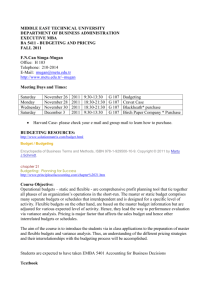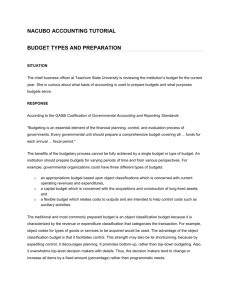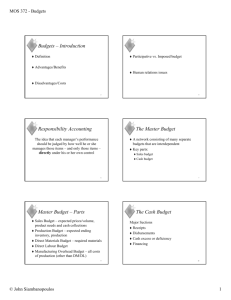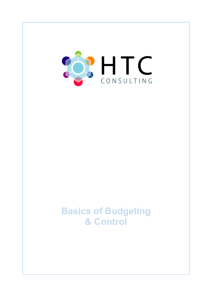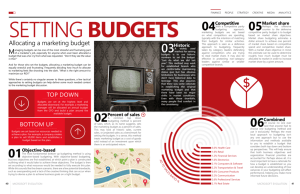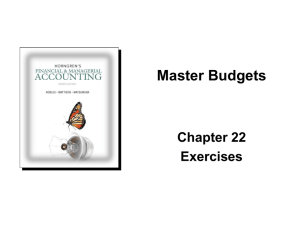budgeting methods
advertisement
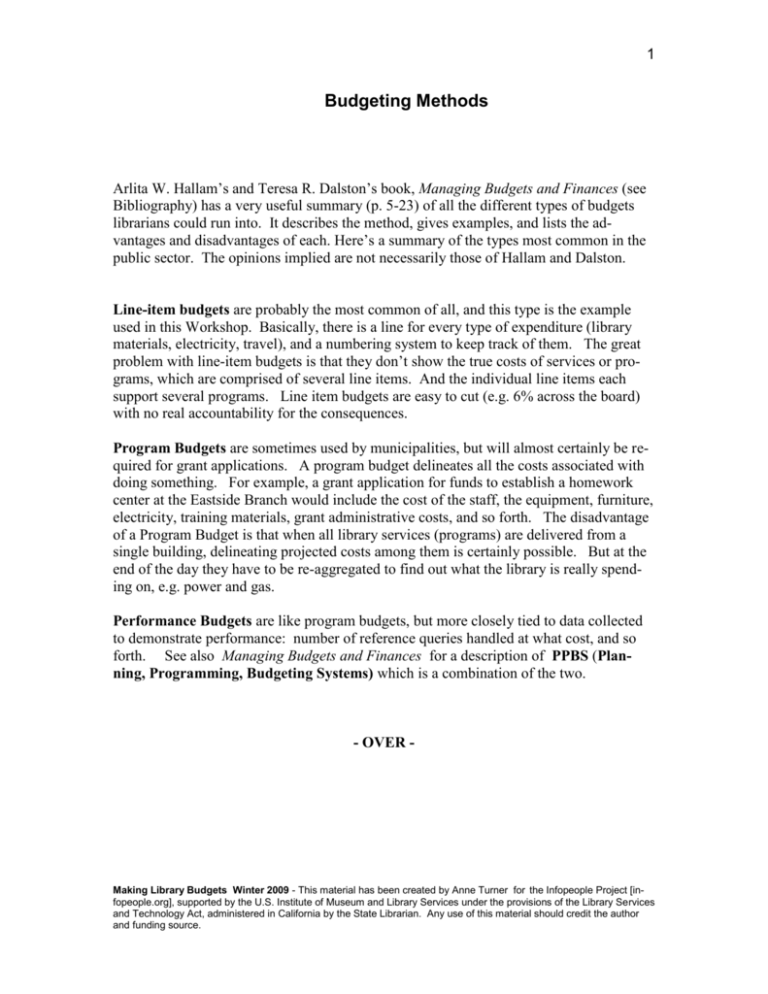
1 Budgeting Methods Arlita W. Hallam’s and Teresa R. Dalston’s book, Managing Budgets and Finances (see Bibliography) has a very useful summary (p. 5-23) of all the different types of budgets librarians could run into. It describes the method, gives examples, and lists the advantages and disadvantages of each. Here’s a summary of the types most common in the public sector. The opinions implied are not necessarily those of Hallam and Dalston. Line-item budgets are probably the most common of all, and this type is the example used in this Workshop. Basically, there is a line for every type of expenditure (library materials, electricity, travel), and a numbering system to keep track of them. The great problem with line-item budgets is that they don’t show the true costs of services or programs, which are comprised of several line items. And the individual line items each support several programs. Line item budgets are easy to cut (e.g. 6% across the board) with no real accountability for the consequences. Program Budgets are sometimes used by municipalities, but will almost certainly be required for grant applications. A program budget delineates all the costs associated with doing something. For example, a grant application for funds to establish a homework center at the Eastside Branch would include the cost of the staff, the equipment, furniture, electricity, training materials, grant administrative costs, and so forth. The disadvantage of a Program Budget is that when all library services (programs) are delivered from a single building, delineating projected costs among them is certainly possible. But at the end of the day they have to be re-aggregated to find out what the library is really spending on, e.g. power and gas. Performance Budgets are like program budgets, but more closely tied to data collected to demonstrate performance: number of reference queries handled at what cost, and so forth. See also Managing Budgets and Finances for a description of PPBS (Planning, Programming, Budgeting Systems) which is a combination of the two. - OVER - Making Library Budgets Winter 2009 - This material has been created by Anne Turner for the Infopeople Project [infopeople.org], supported by the U.S. Institute of Museum and Library Services under the provisions of the Library Services and Technology Act, administered in California by the State Librarian. Any use of this material should credit the author and funding source. 2 Multi-year or two year budgeting is just what it sounds like. A municipality and its constituent departments develop two-year budget projections of revenues and expenses. There are opportunities in the course of the two years to make needed adjustments, but basically this type of budgeting is seen as a useful planning tool. Indeed, proposing a new library program and estimating what it is going to cost (and perhaps save) in Year 1 and Year 2 can be a very helpful in persuading funding authorities to adopt it. The problem with multi-year budgeting is of course the unexpected: the surprise decline in revenues or the inability to respond flexibly when a new problem emerges that a library program might mitigate. Zero-based budgeting is one of those techniques that (in the public sector at least) looks good to the budget-cutters, but may be more trouble than it is worth. Basically, every program gets re-justified from scratch every year. The program is ranked in terms of the Library’s priorities, and then put into a pot with the programs of the other government departments, and ranked again. This enables elected officials to look at the municipality’s entire package of services, and make strategic decisions about funding. Theoretically, zero-based budgeting promotes cooperation among departments (if a city places a priority on services to pre-schoolers, the Library and the Parks and Recreation Department might develop a joint program), but it also takes a lot of time. And it makes programs that are not necessarily exciting, but are nevertheless very important (e.g., Library outreach visits to nursing homes) very vulnerable to cuts. Making Library Budgets Winter 2009 - This material has been created by Anne Turner for the Infopeople Project [infopeople.org], supported by the U.S. Institute of Museum and Library Services under the provisions of the Library Services and Technology Act, administered in California by the State Librarian. Any use of this material should credit the author and funding source.

